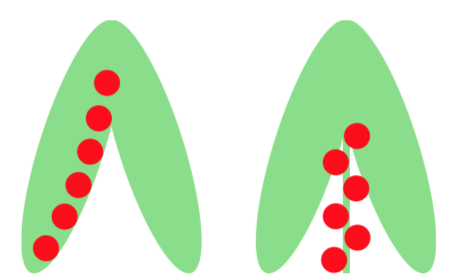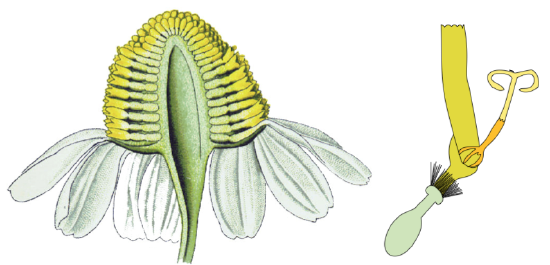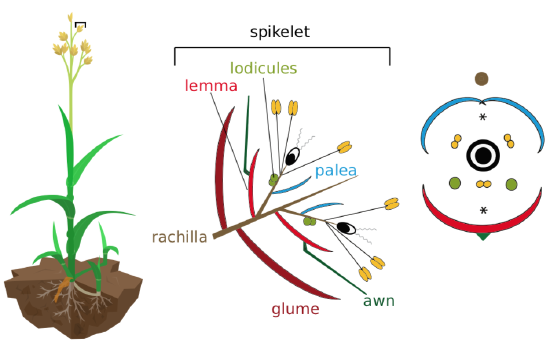8.3: Three plant families you wanted to know but were too afraid to ask
- Page ID
- 18027
Angiosperms is a giant (quarter of million species) class with four subclasses (Figure \(\PageIndex{1}\)):
- Magnoliidae being the most primitive with flowers of numerous free parts (like water lily, Nymphaea, fossil Archaefructus and Amborella);
- Liliidae or monocots are grasses, palms, true lilies and many others with trimerous flowers;
- Rosidae with pentamerous or tetramerous flowers and free petals;
- Asteridae most advanced, bear flowers with fused petals and reduced number of carpels.
Rosids and asterids each comprise about 1/3 of angiosperm diversity.
Among the numerous taxonomic groups described by scientists in the last 300 years, families of flowering plants hold the distinct place. They were established in collaborative efforts of French botanists, namely Michel Adanson and Antoine

Jussieu. Adanson based his research on methods which are now frequently called “bioinformatics” and therefore was long ahead of his time. Jussieu proved Adanson’s ideas by establishing the living garden where plants were arranged by these families. At first, families were not accepted by “fathers of botany” like Carolus Linnaeus. But with time, more and more facts were accumulated which support the ideas enclosed in the families differentiation. The most amazing was almost absolute support of plant families concepts with new molecular methods. Many groups which looked stable (like orders of birds and mammals) appeared less robust than plant families. This is why plant families are so important.
Practically, families provide a great help in knowing plants. For example, the flora of whole North America has 20,000 species of plants. It is almost impossible to remember them all. However, there are only 200 plant families in North America. Therefore, knowing the family saves lots of time and efforts in plant determination.
Several plant families are especially important since they play a big role in economics, form widespread types of vegetation, or are simply extremely rich in species. Three of these families will be characterized below. Characterization of family should follows the plan below:
- Meta-information: name, position in classification, number of species, distribution
- Ecological preferences
- Morphology and anatomy of stem, leaf and root
- Generative organs from inflorescence to fruit, including flower diagrams and formulas. Seed.
- Representatives and their importance
Leguminosae, or Fabaceae—legume family
Belong to rosids (Rosidae). Up to 17,000 species, third largest angiosperm family after Compositae (aster family) and Orchidaceae (orchids). Widely distributed throughout the world, but preferably in tropics. Have root nodules with nitrogen-fixing bacteria. Leaves alternate, pinnately compound (once or twice), with stipules.
Three subfamilies (Caesalpinioideae, Mimosoideae, Papilionoideae) often treated as separate families. Sepals 5, united. Petals 5, in Papilionoideae they are free, unequal and have special names: banner, keel and wing (Figure \(\PageIndex{2}\)), in Mimosoideae they fuse and form tube. Stamens often 10 with 9 fused and one free stamen; in Mimosoideae, stamens are numerous. Singe pistil with single carpel. Flower formula of Mimosoideae is \[\ast K_{(5)}C_{(5)}A_{5-\infty}G_{\underline{1}}\] Papilionoid legumes have formula like \[\uparrow K_{(5)}C_{1,2,2}A_{1,[4+5]}G_{\underline{1}}\]

Fruit is a legume (pod): dehiscent with one camera; this is different from silique of cabbage family (Cruciferae) which has two cameras (Figure \(\PageIndex{3}\)). Mature seeds without endosperm.
Representatives of Leguminosae:
-
Mimosoideae: stamens numerous, petals connected

-Acacia—dominant tree of African and Australian savannas, often with phyllodes
-Mimosa—sensitive plant
- Papilionoideae: stamens 9+1, petals free; this subfamily contains many extremely important food plants with high protein value
-Glycine—soybean
-Arachis—peanut with self-buried fruits
-Phaseolus—bean
-Pisum—pea
Compositae, or Asteraceae—aster family
Belong to asterids (Asteridae). More than 20,000 species—second place in flowering plants. Cosmopolitan, but better represented in temperate and subtropical regions. Prefer open spaces. Herbs, rarely woody plants; store carbohydrates as inulin (not starch), sometimes have resin or laticifers (subfamily Cichorioideae). Leaves are alternate or opposite, without stipules, with pterodromous venation.
Flowers in involucrate heads which mimic one flower (Figure \(\PageIndex{4}\)). Calyx reduced to hairs or bristles (pappus), petals fused in tube or ligula (with 5 or 3 teeth). Stamens 5, fused by anthers, pollen lifted up and distributed by outer sides of stigmas, this is secondary pollen presentation (Figure \(\PageIndex{5}\)). Pistil has 2 carpels, ovary inferior. Fruit is achene, mature seed has almost no endosperm. Flower formula of the tubular (disk) flower is \[\ast K_{\infty}C_{(5)}A_{(5)}G_{\overline{(2)}}\] Ligulate (ray) flower typically has formula like \[\uparrow K_{\infty}C_{(3\vee5)}A_{(5)}G_{\overline{(2)}}\]


Fruit of aster family is one-seeded achene (it is a frequent mistake to call it “seed”). In achene, walls of inferior ovary are tightly fused with seed coat. Achenes frequently bear diverse dispersal structures: trichomes, teeth, hooks and others.
Oil plants, vegetables, ornamentals and medicinal plants distributed in multiple subfamilies, most important are three:
-
Carduoideae: mostly tubular flowers
-Centaurea—knapweed
-Cynara—artichoke
-Carthamus–safflower
-
Cichorioideae: mostly 5-toothed ligulate (pseudo-ligulate) flowers + lacticifers with latex
-Taraxacum—dandelion
-Lactuca—lettuce
-
Asteroideae: tubular + 3-toothed ligulate flowers
-Helianthus—sunflower (BTW, “canola”, or Brassica napus from Cruciferae is the second main source of vegetable oil)
-Artemisia—sagebrush
-Tagetes—marigold and lots of other ornamentals
Gramineae, or Poaceae—grass family
Belong to liliids (Liliidae, monocots). Approximately 8,000 species distributed throughout the world, but most genera concentrate in tropics. Prefer dry, sunny places. Often form turf (tussocks)—compact structures where old grass stems, rhizomes, roots, and soil parts are intermixed. Grasses form grasslands—specific ecological communities widely represented on Earth (for example, North American prairies are grasslands). Stems of grasses are usually hollow and round. Leaves with sheaths.
Flowers reduced, wind-pollinated, usually bisexual, form complicated spikelets. Each spikelet bears two glumes; each flower has lemma and palea scales (Figure \(\PageIndex{6}\)). Perianth is reduced to lodicules. Stamens from 6 to 1 (most often 3), with large anthers. Flower formula is \[\uparrow P_{0-3}A_{0-3+2-3}G_{\underline{(2)}}\]
Fruit is a caryopsis; it includes flower scales. Seed contains embryo with coleoptile, coleorhiza and scutellum (Figure 7.5.7).
Most primitive grasses are bamboos (Bambusoideae subfamily). There are many other subfamilies. Two are especially economically important:
- Pooid (Pooideae) grasses usually are C\(_3\) plants, wheat (Triticum), rice (Oryza), barley (Hordeum) and rye (Secale) belong to this group.
- Panicoid (Panicoideae) grasses are mostly C\(_4\) plants like corn (Zea), sorghum (Sorghum) and sugarcane (Saccharum).



